Wireless Brain Sensors Market Research, 2031
The global wireless brain sensors market was valued at $677.8 million in 2021, and is projected to reach $1.6 billion by 2031, growing at a CAGR of 9% from 2022 to 2031. One of the main drivers of the wireless brain sensor market is the widespread acceptance of sedentary lifestyles. Strokes and migraine are caused by a variety of bad lifestyle choices, including drinking alcohol and smoking. In addition, growing prevalence of (TBI) traumatic brain injuries is anticipated to increase the demand for wireless brain sensors. TBIs are brought on by a blow to the head that causes a temporary or permanent brain injury., domestic violence, and car accidents are among the common causes of TBIs.
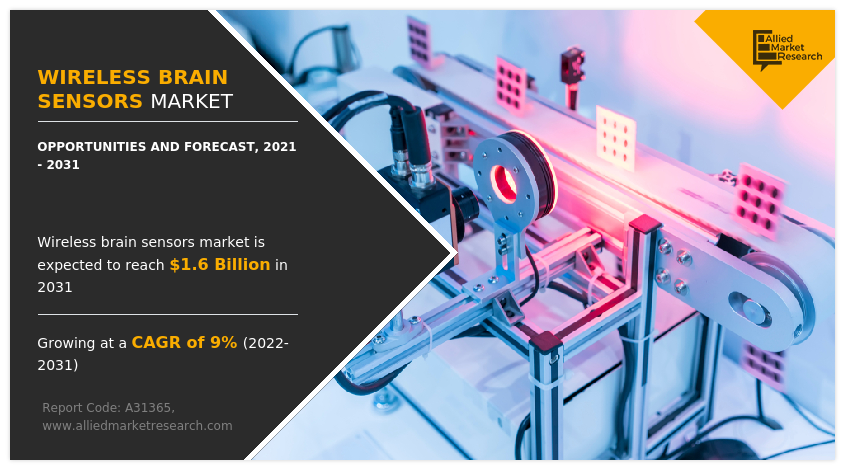
Health-related concerns and high cost of utilizing wireless brain sensors are two factors that are predicted to restrict growth in the global wireless brain sensors market during the forecast period. A wireless brain sensor is an absorbable device made of silicon sheet in the 20-nanimeter range with several water soluble and biocompatible metals, such as magnesium, titanium, and zinc. It may be utilized as a conducting component and is mostly composed of polymers that can be reassembled to change the dissolving rate, which restrains the market expansion.
The demand for wireless brain sensors is likely to be driven by a number of additional factors, including changing social environment, rising research expenditures, technological advancements, growing public awareness of neurological issues, and increase in the prevalence of dementia. The development of brain sensors has been driven by significant breakthrough advancements in brain-computer interfaces. In the coming years, untapped markets and technology innovation may present the wireless brain sensors market forecast with significant opportunities.
The wireless brain sensors market is segmented on the basis of product type, application, end user, and region. By product type, the market is sub-segmented into electroencephalography (EEG) devices, sleep monitoring devices, magnetoencephalography (MEG) devices, and others. By application, the market is classified into Alzheimer’s disease, traumatic brain injury, epilepsy, sleep disorders, and others. By end user, the market is classified into hospitals, research and academic institute/laboratories, homecare settings, and others. By region, the market is analyzed across North America, Europe, Asia-Pacific, and LAMEA.
The key players profiled in this report include, NeuroSky, EMOTIV, Advanced Brain Monitoring, Inc., Koninklijke Philips N.V., Medtronic, Muse, Natus Medical Incorporated, Cadwell Industries, Inc., NeuroWave Systems Inc., and BrainScope.
The wireless brain sensors market is segmented into Product Type, Application and End User.
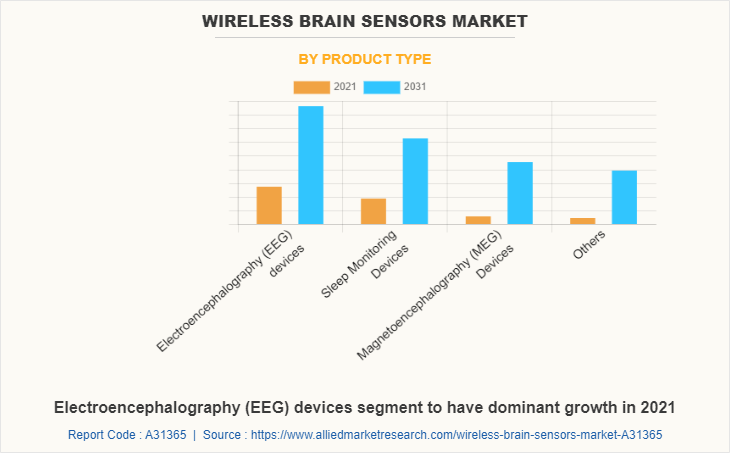
By product type, the electroencephalography (EEG) devices segment dominated the market in 2021. EEG devices are capable of capturing the electrical activity of the brain. The gadget aids in the collection of electrical activity from the brain. The acquired signals are digitalized and amplified before being transferred to a mobile device or computer for data processing and storage. Individuals may also utilize this gadget to enhance their well-being and productivity by tracking their emotions and mood. The growing occurrence of traumatic brain injuries, migraine, and strokes globally, is driving the expansion of the global wireless brain sensors market opportunity.
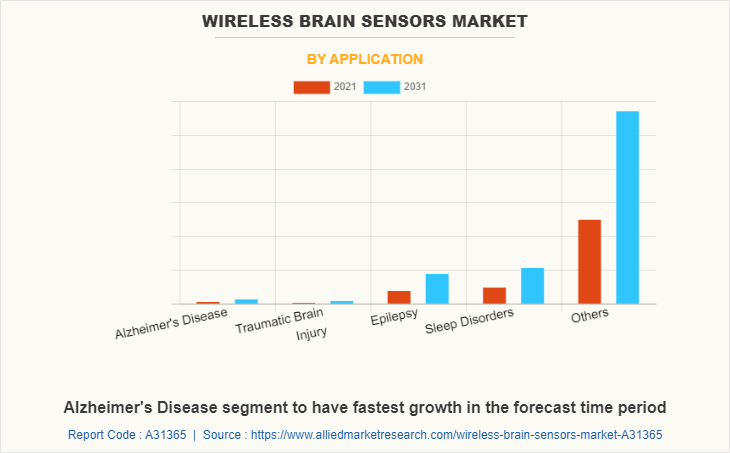
By application, the Alzheimer's disease segment had the fastest growth in the global wireless brain sensors market share in 2021. Alzheimer's disease (AD) is a significant and fast-expanding drain on the healthcare system. Increasing amount of research suggests that cognitive, behavioral, sensory, and motor impairments may occur several years before the clinical signs of Alzheimer's disease. Existing neurodegenerative disease diagnostic tools, while well-validated, are frequently less successful in detecting departures from the usual cognitive decline trajectory in the early stages of the disease.
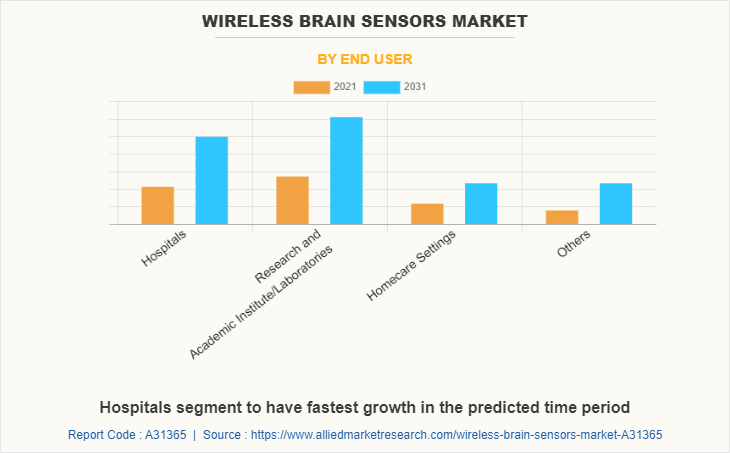
By end user, the hospitals segment had fastest growth in the global wireless brain sensors market growth in 2021. Hospitals are currently making technological advancements. In hospitals, technologically advanced equipment is widely used to deliver better care. These tools not only make treatment methods simpler, but they also produce better, quicker, and more precise results. The majority of neurological diseases and disorders, including severe TBIs, are identified and treated using cutting-edge tools, employed by trained neurologists and found at specialized hospitals. In addition, hospitals see a much higher influx of patients with head injuries than do clinics or other end users.
By region, North America dominated the global wireless brain sensors market size in 2021 and is projected to remain the fastest-growing sub-segment during the forecast period. Due to its developed healthcare system and rising occurrence of traumatic brain injuries, North America now controls the majority of the global market for wireless brain sensors. In addition, the market growth rate in this region is expected to be further accelerated by technical development and a favorable reimbursement environment. In addition, the wireless brain sensors market in North America is expected to grow significantly during the forecast period. Due to the large target group and significant unmet demand for minimally invasive methods, the top players in the wireless brain sensors market are expected to have promising growth prospects.
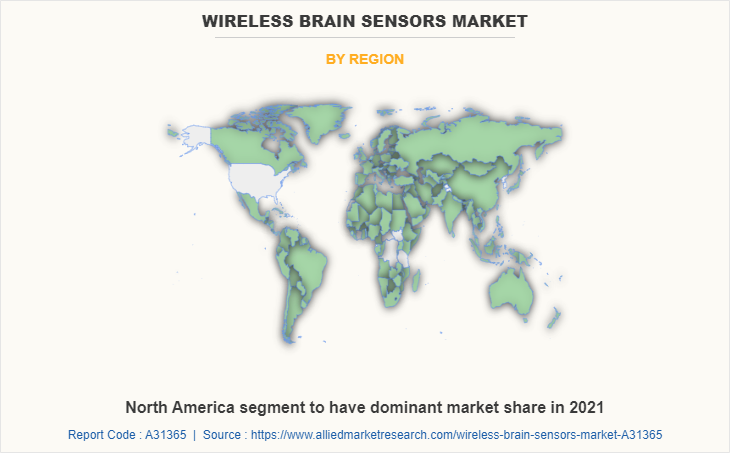
Key Benefits For Stakeholders
- This report provides a quantitative analysis of the market segments, current trends, estimations, and dynamics of the wireless brain sensors market analysis from 2021 to 2031 to identify the prevailing wireless brain sensors market opportunities.
- The market research is offered along with information related to key drivers, restraints, and opportunities.
- Porter's five forces analysis highlights the potency of buyers and suppliers to enable stakeholders make profit-oriented business decisions and strengthen their supplier-buyer network.
- In-depth analysis of the wireless brain sensors market segmentation assists to determine the prevailing market opportunities.
- Major countries in each region are mapped according to their revenue contribution to the global market.
- Market player positioning facilitates benchmarking and provides a clear understanding of the present position of the market players.
- The report includes the analysis of the regional as well as global wireless brain sensors market trends, key players, market segments, application areas, and market growth strategies.
Impact of COVID-19 on the Global Wireless Brain Sensor Industry
- COVID-19 has negatively impacted various industries, such as healthcare, which has led to a drastic decline in healthcare sales. As wireless brain sensor is widely used in healthcare manufacturing, there was significant reduction in the wireless brain sensor demand globally
- Sales of wireless brain sensors are directly proportional to the demand from end-use industries, namely hospitals, research and academic institute/laboratories, homecare setting, and others. However, the demand for wireless brain sensor in the healthcare industry was greatly affected owing to import-export restrictions, closed borders, and supply chain disruptions due to the outbreak of the COVID-19 pandemic
- Economic slowdown affected the setup of new wireless brain sensor projects across the globe as majority of government fundings were diverted towards the healthcare sector owing to rapid spread of the COVID-19 virus, impacting the market to the great extent
Wireless brain sensors Market Report Highlights
| Aspects | Details |
| Market Size By 2031 | USD 1.6 billion |
| Growth Rate | CAGR of 9% |
| Forecast period | 2021 - 2031 |
| Report Pages | 250 |
| By Product Type |
|
| By Application |
|
| By End User |
|
| By Region |
|
| Key Market Players | Neuronetrix Solutions, LLC, Neurosky, Inc., Advanced Brain Monitoring, Masimo Corporation, the brain resource company, neuroelectrics, Emotiv, Inc., Quantum Sensors, Brain Scientific |
Analyst Review
One of the main factors boosting the adoption of wireless brain sensors is the increase in unhealthy lifestyles globally. Stroke and migraine are often caused by decisions about unhealthy lifestyles, such as smoking and alcoholism. According to some reliable sources, some of the lifestyle factors that impact health are exercise, diet, weight record, and substance misuse, and many others, which are expected to fuel growth of the market during the forecast period. However, the high cost associated with sensors and complexities in understanding product functionality are the key factors expected to hamper market growth during the forecast period.
Rise in the number of government initiatives along with the advancements in clinical development framework of developing nations are expected to provide beneficial opportunities for the wireless brain sensors market growth. Moreover, increasing demand for wireless brain sensors from emerging markets and technological advancement are further anticipated to expand the wireless brain sensors market growth rate in the future.
Among the analyzed regions, North America is expected to account for the highest revenue in the market by the end of 2031, followed by Asia-Pacific, Europe, and LAMEA. Due to the rising frequency of TBIs, established healthcare infrastructure, attractive reimbursement policies, and regulatory reforms in the healthcare industry, the region is anticipated to experience the fastest growth rate during the forecast period are the key factors responsible for leading position of North America and Asia-Pacific in the global wireless brain sensors market.
The global acceptance of sedentary lifestyles is one of the key reasons driving the market for wireless brain sensors. Alcoholism and smoking are only two instances of the unhealthy lifestyle choices that are predicted to result in stroke and migraine. In addition, rise in brain-related disorders globally is likely to provide a business opportunity in the near future.
The leading application of a wireless brain sensors market is to analyze and measure the electrical signals generating in the brain.
LAMEA is expected to provide more business opportunities for the global wireless brain sensors market in the future.
NeuroSky, EMOTIV, Advanced Brain Monitoring, Inc., Koninklijke Philips N.V., Medtronic, Muse, Natus Medical Incorporated, Cadwell Industries, Inc., NeuroWave Systems Inc., and BrainScope are the major players in the wireless brain sensors market.
Healthcare industry leaders and pharmaceutical manufacturers are the major the major customers in the global wireless brain sensors market.
Loading Table Of Content...


